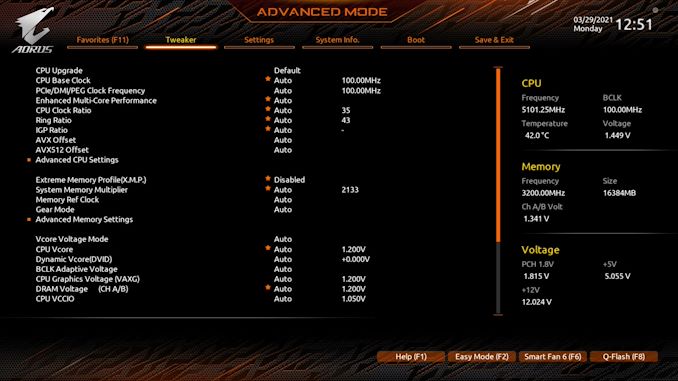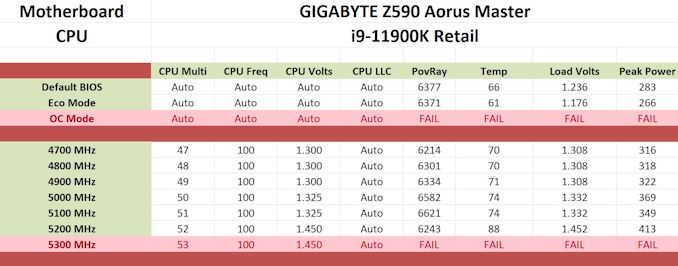GIGABYTE Z590 Aorus Master Review: Soaring High With Rocket Lake
by Gavin Bonshor on April 28, 2021 1:00 PM ESTOverclocking
Experience with the GIGABYTE Z590 Aorus Master
Over the last couple of years, both Intel and AMD have been pushing the boundaries on their processor clock speeds, not just at stock but in its own interpretations of automatic overclocking. Intel, for example, has refined its technology on the i9 series with what it calls Adaptive Boost Technology (ABT). This is in addition to its Thermal Velocity Boost (TVB). While seemingly complicated with varying levels of effect, when properly cooled with adequate CPU coolers, it can boost overall system performance in single and multi-threaded applications. This throws a new dimension to manual overclocking as new processors such as Rocket Lake, when paired with Z590 motherboards, can have varying levels of effects, most generally through different vendor firmware and power limit restrictions.
For the best possible performance, an all-core overclock at maximum frequency is better than one or four cores boosted, with the others lagging behind in terms of frequency, especially for tasks where multiple threads are being utilized. This, however, comes at the cost of negative thermals and, in the case of Rocket Lake, gargantuan levels of power consumption. All-in-all, this means users looking to overclock Rocket Lake beyond its default limitations will need adequate and premium cooling, as well as a capable power supply.
Focusing on our experience with the GIGABYTE Z590 Aorus Master, it's very well equipped to handle some of the most ardent overclocks when doing this with ambient cooling methods. There is certainly potential to stretch beyond that with sub-ambient methods such as DICE (solid carbon dioxide) and LN2 (liquid nitrogen), especially due to the large 18+1 (9+1) power delivery the board is equipped with. The GIGABYTE Aorus firmware is one we've seen multiple times over the years, and the layout itself is straightforward to navigate, with all of the board's overclocking variables found under the Tweaker sub-menu.
All of the overclocking options are listed in one menu, with the CPU frequency ratio, Cache frequency ratio, and Baseclock frequency rations featured at the top. Towards the middle is the memory settings where users can enable memory with X.M.P 2.0 profiles by enabling it in the menu, or go in-depth and do this manually with extensive options for memory latencies, as well as Intel's new Gear Mode, which can enable to run the memory controller at full speed in a 1:1 ratio, or at half speed in a 2:1 ratio for even more impressive memory overclocks.
As users scroll through the Tweaker section, all of the voltage and power options are towards the bottom, with plenty of options and settings designed to make the most out of overclocking with Rocket Lake and even Comet Lake. However, some of these features, such as Gear Mode, will be disabled when used with 10th Gen Intel chips.
Overall, GIGABYTE's UEFI firmware is easy to overclock with and allows access to all of the relevant frequency, voltage, and power options to achieve the maximum overclock depending on the quality of the silicon. The firmware itself is stable and responsive, which is consistent with other GIGABYTE models we have used over the last couple of years.
Overclocking Methodology
Our standard overclocking methodology is as follows. We select the automatic overclock options and test for stability with POV-Ray and Prime95 to simulate high-end workloads. These stability tests aim to catch any immediate causes for memory or CPU errors.
For manual overclocks, based on the information gathered from the previous testing, start off at a nominal voltage and CPU multiplier, and the multiplier is increased until the stability tests are failed. The CPU voltage is increased gradually until the stability tests are passed. The process repeated until the motherboard reduces the multiplier automatically (due to safety protocol) or the CPU temperature reaches a stupidly high level (105ºC+). Our testbed is not in a case, which should push overclocks higher with fresher (cooler) air.
Overclocking Results
The GIGABYTE Z590 Aorus Master didn't have any overclocking profiles for users to enable, but it has two modes outside of the default settings: OC mode and Eco mode. When comparing GIGBAYTE's Eco mode with default settings using our Core i9-11900K, we saw similar performance levels in our POV-Ray benchmark. Still, Eco mode dialed down the CPU VCore by around 4%, which saw a lower operating temperate of 5ºC and a lower power draw by 6%. When testing the OC Mode, which gives the firmware free reign to automatically overclock the processor what it thinks will be stable, we found it wasn't stable at all and would frequently crash when we ran POV-Ray. Whether this is something GIGABYTE will improve upon in later firmware editions remains to be seen.
Performing our manual overclock testing from 4.7 to 5.3 GHz, we saw very consistent levels of VDroop performance on the CPU VCore. The CPU VCore values set in the firmware compared to the CPU VCore at load were very similar, which means the GIGABYTE's default LLC profile is quite aggressive. This can be beneficial to ensuring stability when overclocking, but it can also mean that the CPU will pull more power from the wall. Compared to the ASRock Z590 Taichi, at 4.9 GHz with a CPU VCore of 1.300 V, the GIGABYTE consumed around 7% more than the ASRock. We saw the only anomaly when we tested at 5.2 GHz, which we believe is due to a power limitation or thermal restriction as our POV-Ray performance was a lot lower than expected. When we test overclocks, we leave the power limits at the defaults in the firmware.
Overall the Z590 Aorus Master performed well and has a lot of potential to be an excellent board for overclocking and pushing the performance limits of Rocket Lake. The levels of VDroop at default settings were consistent throughout our testing, and we were happy with the overall overclocking performance of the board.












39 Comments
View All Comments
Oxford Guy - Thursday, May 6, 2021 - link
'well just because they eliminated a warranty option may just mean no one was buying it'I'll buy that for a dollar.
JVC8bal - Wednesday, April 28, 2021 - link
Overall, I am happy with this product. DDR-4400, overclocked 11900k at 5.1ghz all cores, gen4 NVMe SSD, 3080 running 16x gen4.However, there was an issue that x570 PCIE gen4 users encountered, that they seem to be correcting. If you had a gen4 NVMe + gen4 graphics card, every 300ms you would get a WHEA-LOGGER event and the computer would BSOD every 1-2 hours. After many responsive emails from their customer support, BIOS version f5d now allows a NVMe gen4 + graphics gen4 without crashing. There is still a WHEA-LOGGER message every 300ms which is noise, but that should be fixed with a future Intel Chipset update.
skaurus - Thursday, April 29, 2021 - link
You talking about AMD chipset issue, but this motherboard is based on Intel chipset. Completely another story.JVC8bal - Friday, April 30, 2021 - link
Yet the issue was the same: an implementation problem of the PCIE 4.0 specs for first-generation platforms. But thank you for feeling it necessary to respond with the simplistic obviology.Spunjji - Thursday, April 29, 2021 - link
Given how none of that second paragraph was relevant to this article, you look suspiciously like you're repeating keywords to maintain the prevalence of specific, already-resolved issues pertaining to Intel's competitors in search-engine rankings. What a mess.JVC8bal - Friday, April 30, 2021 - link
Actually, after doing a RMA on 3 of these boards to find the problem, I felt inclined to respond to the review. Others might be having this same issue. They will just need to update to the latest BIOS to avoid crashes with that combination of hardware. I don't why people like you feel the need to respond with conspiracy theories.WaltC - Thursday, April 29, 2021 - link
Sorry, man--but I installed a PCIe4 5700XT into my x570 Aorus Master back in July 2019--about 21 months or so. And I've never--not even once--had any of the problems you allude to...;) It's been solid as a rock. Someone has badly misled you--it's just common old anti-AMD FUD. Very immature hogwash.JVC8bal - Friday, April 30, 2021 - link
Google "whea-logger and pcie 4". x570 was the first platform to experience this manifestation of the problems This was helpful in identifying the problem of specific gen4 NVMe drives conflicting with gen4 graphics cards. Speaking of immature, what a response... not just words, but the logic: somehow your 1-off, personal experience is indicative over broader reality? It's anti-AMD propaganda?TheinsanegamerN - Friday, April 30, 2021 - link
"I dont have a problem therefore the problem does not exist and anyone who says otherwise is immature, look how mature and sohpisticated i am! My farts smell like cinnamon!"silverblue - Friday, April 30, 2021 - link
Is that with all the necessary security patches applied? AMD processors are more secure than their Intel competitors right now. AMD also offered PCIe 4.0 for nearly two years before Intel got in on the act. Finally, AMD CPUs are simply more efficient.Three for the search engines to chew on.